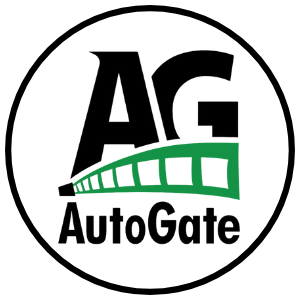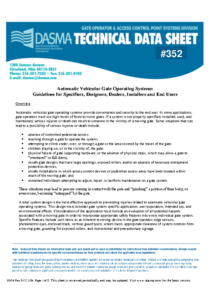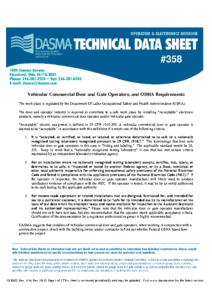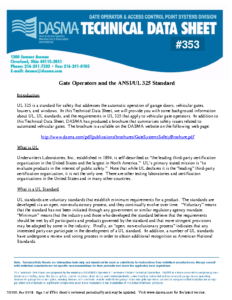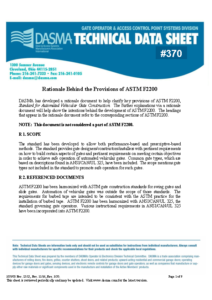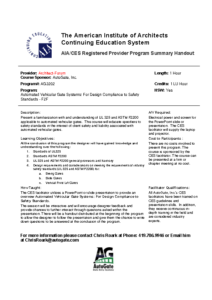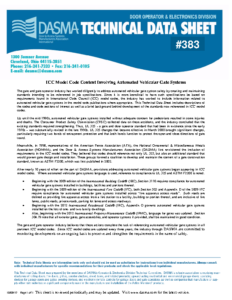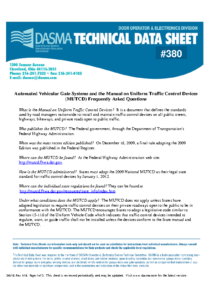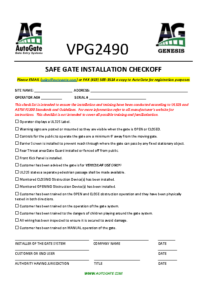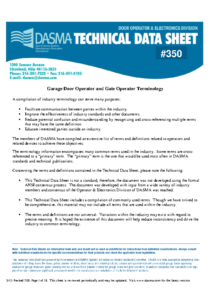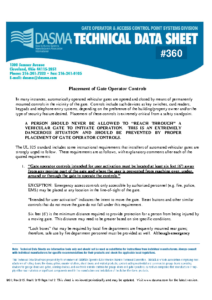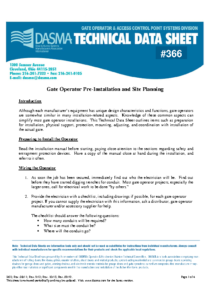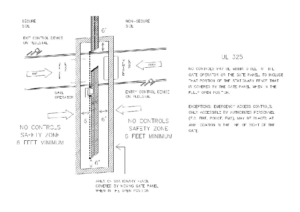Click for Additional Details
- Contains the basic qualifying factors that products must meet in order to be documented (listed) and marked (labeled) as complying with the requirements of the UL 325 Voluntary Listing and Labeling Program;
- Provides methods for testing products, primarily related to safety performance;
- Covers installation of the products in accordance with the National Electric Code, which is maintained by the National Fire Protection Association and is in force nationwide (UL 325 is to be “harmonized” with this code) and
- Addresses safety concerning potential fire and electrical hazards as well as the safety of the general public.
Based on this, UL 325 is used as a basis to test products at a nationally recognized testing laboratory. Gate operator manufacturers that choose to participate in the listing and labeling program must submit their products for testing. If the laboratory finds them to be in compliance with the UL 325 standard, they are listed and receive a mark (label) indicating that compliance. It is very important to remember that there are laboratories other than UL that are capable of listing and labeling products; however, only products tested by UL can receive a UL label. Therefore, a UL label is not a generic term and should not be used in that manner. It is also important to understand that UL and the other laboratories do not “approve” products. Approval implies acceptance of responsibility for compliance with the standards when this responsibility ultimately lies with the applying manufacturer and not with the laboratory (the burden of proof of compliance always lies with the manufacturer). In general, UL 325 contains of the following highlights as regards gate operators:
- A glossary that defines each type of operator,
- A separation of gate operators into “classes;”
- Entrapment protection criteria for each class of operator;
- Entrapment alarm criteria;
- Requirements for gate construction and installation and
- Instructional requirements placing increased responsibility on the installers of gates and gate operators.
The term “entrapment,” as used in relation to gates and gate operators in UL 325, is defined as “the condition when an object is caught or held in a position that increases the risk of injury.” A key part of the UL 325 Standard is the table that summarizes the entrapment device options for the different classes of gate operators of the various types of gate included in the standard. We have listed the provisions in the following sections.
Table 32.1 of UL 325 – Protection Against Entrapment
Gate Operator Category
Horizontal Slide, Vertical Lift and Vertical Pivot Swing and vehicular Barrier Arm
Entrapment protection types permitted: Entrapment protection types permitted:
A, B1, B2 or D (See definition below) A, B1, B2, C or D (See definition below)
Note: The same type of devices shall not be utilized for both entrapment protection means. Use of a single device to cover both the opening and closing directions is in accordance with the requirement.
Entrapment protection types A, B1, B2, C, and D are:
Type A: Inherent entrapment protection system.
Type B1: Non-contact sensor (Photoelectric sensor or the equivalent).
Type B2: Contact sensor (Edge or the equivalent).
Type C: Inherent force limiting, inherent adjustable clutch or inherent pressure relief device. Note: UL 325 permits these only in swing gates and barrier arms.
Type D: Actuating device requiring continuous pressure to maintain opening or closing motion of the gate, within line of sight of the gate.
Table 32.2 of UL 325 – Minimum Quantity of Entrapment Protection Means
Horizontal Slide Gate 2 for the Opening Cycle 2 for the Closing Cycle
Horizontal Swing Gate 2* for the Opening Cycle 2* for the Closing Cycle
Vertical Pivot Gate 2 for the Opening Cycle 2 for the Closing Cycle
Vertical Lift Gate 1 for the Opening Cycle 1 for the Closing Cycle
* For a horizontal swing gate operator, at least two independent entrapment protection means are required in each direction of travel. Except, if there is no entrapment zone in one direction of travel, only one means of entrapment protection is required in that direction of travel; however, the other direction must have two independent entrapment protection means.
- Gate operator manufacturers, and
- Gate operator installers
Gate operator manufacturers must follow strict guidelines in order to maintain their UL listing. Gate operator installers are key to completing the UL compliance process. Manufacturers issue specific instructions that must be followed by the installer to maintain UL compliance. Installers are required to follow these instructions and identify entrapment areas and hazards that exist for their site. Entrapment is preventable. The additional cost of purchasing products, accessories, and installing per the UL 325 standard varies by gate operator type and brand. Slide and swing operators have a tendency to be more costly to install than a VPG due to the additional equipment requirements. No matter which system you decide to install, choose safety first. Choose a UL 325 Listed gate operator, identify all possible entrapment areas, and properly install entrapment protection devices.
UL 325 and ASTM F2200 are specifically intended to work together under a harmony principle. Adhering to and understanding these standards can provide the owner with both the safety and security that a well installed automated gate system can provide. Automated vehicular gates are, by design, intended to provide security and to limit access to property. This can result in a delicate balancing act between security and safety. The need for security does not offset responsibility to prevent injuries due to entrapment, from protrusions or pinch points, or simple child’s play. Knowing, understanding and consistently following UL 325 and ASTM F2200 standards is a fundamental aspect of gate operator installer professionalism.
